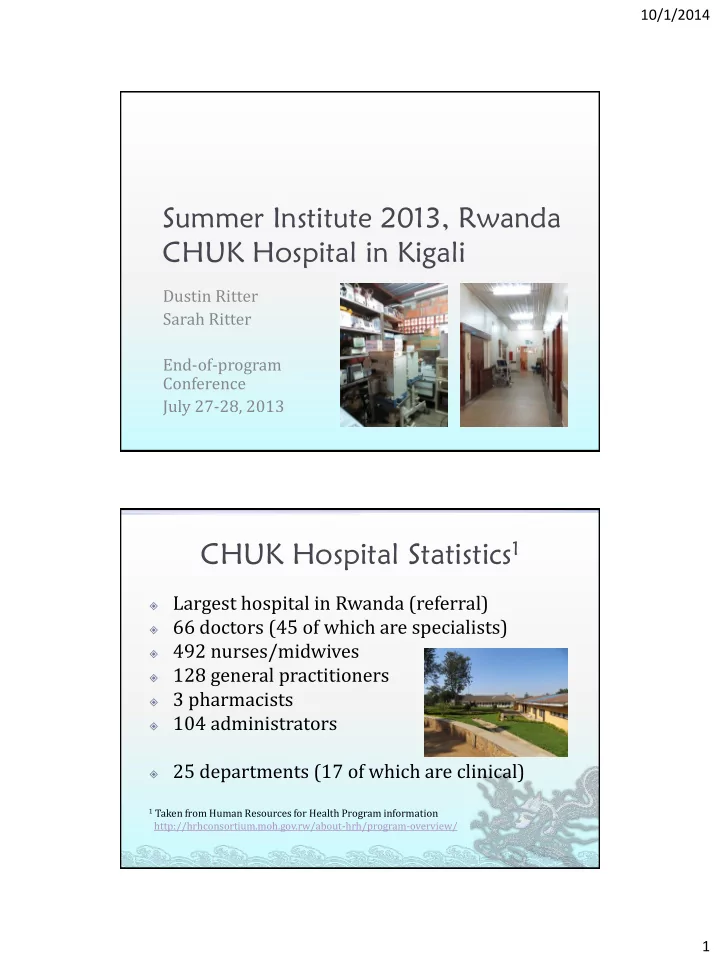

10/1/2014 Summer Institute 2013, Rwanda CHUK Hospital in Kigali Dustin Ritter Sarah Ritter End-of-program Conference July 27-28, 2013 CHUK Hospital Statistics 1 Largest hospital in Rwanda (referral) 66 doctors (45 of which are specialists) 492 nurses/midwives 128 general practitioners 3 pharmacists 104 administrators 25 departments (17 of which are clinical) 1 Taken from Human Resources for Health Program information http://hrhconsortium.moh.gov.rw/about-hrh/program-overview/ 1
10/1/2014 People We’ve Met Jean Claude: Head of maintenance at CHUK BMETs: Maurice, Philemon, Francois, Moise, Jean Pierre, Gilbert, Albert, Alain, Jean Baptiste Baudouin from Craft Engineering People We’ve Met Rwandan nurses and doctors Doctors and administrators from the Human Resources for Health Program Dr. Cliff; Dr. Mark; Cari (not pictured) 2
10/1/2014 Goals of the Human Resources for Health Program To “…build the healthcare education infrastructure and workforce necessary to create a high quality, sustainable healthcare system in Rwanda…” By addressing the following obstacles: Shortage of skilled healthcare workers Poor quality of education for healthcare workers Inadequate infrastructure and equipment Inadequate management of health facilities http://hrhconsortium.moh.gov.rw/about- hrh/program-overview/ How will they do it? Team with 23 top US institutions Institutions will provide full-time medical, nursing, health management, and dentistry faculty Transfer knowledge and train specialists Outcomes: Train 550 medical specialists Upgrade skill sets of over 5000 nurses Introduce formalized training for health management and dentistry http://hrhconsortium.moh.gov.rw/about- hrh/program-overview/ 3
10/1/2014 Primary Project: Repairing Medical Equipment Total # of pieces of equipment: 34 Repair Rate: Total # returned to service: 29 ~85% Total # abandoned: 5 Source of problem: Motor (1) Mechanical simple (2) Electric simple (17) Power supply (7) Other (7): broken probe; broken LCD screen; broken plastic connector on filter, etc. Reasons for abandoning repair: Broken transformer: 2 Missing spare part: 3 Pulse oximeter (x3) Adjust screen display Vital #s visible Fetal monitor (1) Wires (2) Solder wires (3) Secure cord (4) Happily ask disconnected from directly to pins with zip tie to try to nurse to verify power supply inside, avoiding prevent further monitor repaired; connector; pins power supply problems tested on mother- detached from connector to-be in labor! inner circuit 4
10/1/2014 Examination Lamp (Repair 1) (1) One of the wires (2) Solder wire; secure (3) Thumbs up completely disconnected with heat shrink; secure for working remote with zip tie exam light Examination Lamp (Repair 2) (1) Metal bar (neutral) (2) Live inside of (3) Working again after disconnected connector broken soldering live wire and strengthening ground bar Phototherapy Units (2) • Start: phototherapy unit on ( top) has 2 out of 5 working bulbs and on ( bottom) has 4 out of 16 • After checking bulbs and cleaning both units, ended with top unit having 5 working bulbs and bottom unit having 8 (covering top but not bottom of 360° unit) 5
10/1/2014 Portable X-ray (1) Hand-held (2) Wire completely (3) Reassemble and have x-ray remote for portable disconnected within technician verify by taking x-ray x-ray broken connector Power Strip (1) CPAP not (2) 2 switches show (3) Use zip ties to (4) 6 working working ( twice ) signs of fire; wire hold cable in place outlets! because plugged into outlets directly to 1 of 3 broken outlets avoid switches on power strip Temperature probe (1) Two broken temp. (2) Combine the two for one working temperature probes for infant warmer; probe; use heat shrink to protect wires from shorting 1 without sensor & 1 with and provide strength broken plug Infant Incubator (1) Switch broken; (2) Melted plastic (3) Completely (4) Test unit; all rebuilt switch, used epoxy to hold to correct position alarms work; pin in place of metal piece which works! holds set temp. 6
10/1/2014 Negatoscopes (2) (1) Two broken negatoscopes; (2) Negatoscope on left negatoscope on right plugged into needed new starters, bulbs, outlet with no power; electrician and switch rewired to bring power (3) Both work! Secondary Project: Securing Laptops 9 laptop computers donated by university in U.S. for teaching and point-of-care use at CHUK/CHUB Dr. Cliff interested in method for securing laptops within departments We scavenged computer-on-wheels (COWs) to serve as portable desk for the computer, and with Claude’s help, asked machinist to build metal device to secure computer onto COWs We also purchased locks for each of the computers for secondary deterrent 7
10/1/2014 Needs-Finding Assessment CHUK Hospital has a large amount of very impressive equipment However, testing/diagnostic equipment for repair and preventative maintenance is scarce Top 3 diagnostic equipment needs: Electrical safety analyzer (leakage current) Must detect the presence of leakage current Defibrillator tester Must provide quantitative assessment of energy delivered Incubator tester (temperature, noise level, humidity level, etc.) Must measure noise level 8
10/1/2014 Thoughts and Lessons Learned Procurement is one of the main sources of difficulty regarding healthcare Spare parts take months or years to obtain Equipment sits unused for long periods of time/indefinitely A holistic approach to moving forward is requisite for healthcare in Rwanda Train doctors and nurses (HRH) Train BMETs (EWH) Educate about the importance of equipment maintenance/repair and role of BMETs Thoughts and Lessons Learned Cont’d Most nurses/doctors we’ve met seem eager to learn and want to be better trained Regarding design for developing countries: Must be rugged (we’ve witnessed that the nurses are not careful with their equipment) Must be rapid (nurses and doctors here are extremely busy and do not have time to wait) Must require few, if any, spare parts; any spares and maintenance needs should be included 9
10/1/2014 Questions?? Other items we repaired 10
Recommend
More recommend